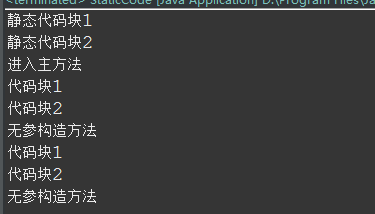package com.zcd; public class StaticCode { public static void main(String[] args) { System.out.println("进入主方法"); StaticCode sc = new StaticCode(); sc = new StaticCode(); } public StaticCode() { System.out.println("无参构造方法"); } { System.out.println("代码块1"); } { System.out.println("代码块2"); } static{ System.out.println("静态代码块1"); } static{ System.out.println("静态代码块2"); } }
执行结果如下:

结论:
①、静态代码块是在Java虚拟机加载类的时候执行的。所以静态代码要比类的主方法还要先执行。而且,不管为该类创建多少个对象,静态代码块只执行一次。
②、非静态代码块是在创建类的时候执行的,注意主方法在非静态代码块之前执行的。
一个类中有静态同步方法和非静态同步方法,静态同步方法与非静态同步方法之间是不会有竞态条件。锁的是两个对象,一个锁的是类,一个锁的是类的对象。所以不会影响。
下面贴一个例子:
package com.zcd; public class ThreadTest4 { public static void main(String[] args) { Example example = new Example(); TheThread1 t1 = new TheThread1(example); example = new Example();//如果把这句注释掉,变成一个对象两个线程,还是打印乱序。 TheThread2 t2 = new TheThread2(example); t1.start(); t2.start(); } } class Example { static{ System.out.println("静态代码块1"); } static{ System.out.println("静态代码块2"); } public synchronized void execute1() { for(int i = 0; i < 50; i++) { System.out.println("example: " + i); } } public static synchronized void execute2() { for(int i = 0; i < 50; i++) { System.out.println("example: " + i); } } } class TheThread1 extends Thread { private Example example; public TheThread1() { } public TheThread1(Example example) { this.example = example; } @Override public void run() { this.example.execute1(); } } class TheThread2 extends Thread { private Example example; public TheThread2() { } public TheThread2(Example example) { this.example = example; } @Override public void run() { this.example.execute2(); } }